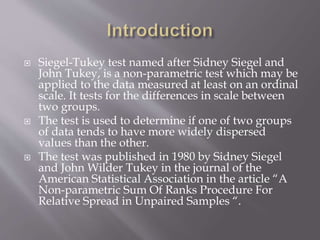
The siegel-tukey-test-for-equal-variability
- 1. Siegel-Tukey test named after Sidney Siegel and John Tukey, is a non-parametric test which may be applied to the data measured at least on an ordinal scale. It tests for the differences in scale between two groups. The test is used to determine if one of two groups of data tends to have more widely dispersed values than the other. The test was published in 1980 by Sidney Siegel and John Wilder Tukey in the journal of the American Statistical Association in the article “A Non-parametric Sum Of Ranks Procedure For Relative Spread in Unpaired Samples “.
- 2. Each sample has been randomly selected from the population. The two samples are independent of one another. The level of measurement the data represent is at least ordinal. The two populations from which the samples are derived have equal medians.
- 3. Null hypothesis H0 : δ2 A = δ 2 B When the sample sizes are equal , then sum of the ranks also will be equal. ԐR1 = ԐR2 Alternate hypothesis H1: δ2 A ≠ δ 2 B
- 4. 2) α=0.05 3) Test statistic Siegel-Tukey test 4) Calculations By combining the groups. The ranking is done by alternate extremes (rank 1 is lowest, 2 and 3 are the two highest, 4 and 5 are the two next lowest etc) Sum the rank of first and second group, after this procedure apply Mann-Whitney U test to find out the U value.
- 5. U1 = n1n2+n1(n1+1)/2‒ ԐR1 U2 = n1n2+n2(n2+1)‒ԐR2 U = Min( U1,U2) 5)Critical region Ucal ˂ Utab ˂ Ucal 6) Conclusion Accept or reject H0
- 6. Two plastics each produced by a different process were tested for ultimate strength. The measurement shown below represent breaking load in units of 1000 pounds per square inch. Plastic 1: 15.3, 18.7, 22.3, 17.6, 15.1, 14.8 Plastic 2: 21.2, 22.4, 18.3, 19.3, 17.1, 27.7 Use Siegel-Tukey test to test the hypothesis that : δ2 1 = δ 2 2
- 7. 1) H0 : : δ2 1 = δ 2 2 H1: δ2 1 ≠ δ 2 2 2) α=0.05 3) Test statistic Siegel-Tukey test 4) Calculations Arrange combine samples in ascending order,
- 8. 14.8, 15.1, 15.3, 17.1, 17.6, 18.3, 18.7, 19.3, 1 4 5 8 9 12 11 10 21.2, 22.3, 22.4, 27.7 7 6 3 2 R1 = 1+4+5+9+11+6 = 36 R2 = 8+12+10+7+3+2 = 42 U1 = n1n2+n1(n1+1)/2‒ ԐR1 = 36+6( 6+1 ) /2 – 36 =21
- 9. U2 = n1n2- U1 = 36 – 21 U2 = 15 U = min ( U1 , U2 ) U = min ( 21 , 15 ) U = 15 5) Critical region If U cal lies between 5 and 31 we accept H0, otherwise we will reject
- 10. 6) Conclusion As the calculated value of U lies in the interval 5 and 31. So, we accept the null hypothesis.
- 11. X1 : 10, 10, 9, 1, 0, 0 X2 : 6, 6, 5, 5, 4, 4 SOLUTION: 1) H0 : : δ2 1 = δ 2 2 H1: δ2 1 ≠ δ 2 2 2) α=0.05 3) Test statistic Siegel-Tukey test
- 12. 4) Calculations Arrange combine samples in ascending order, Arrange data set 0, 0, 1, 4, 4, 5, 5, 6, 6, 9, 10, 10 Ranks 1 4 5 8 9 12 11 10 7 6 3 2 Tied adjusted rank 2.5, 2.5, 5, 8.5, 8.5, 11.5, 11.5, 8.5, 8.5, 6, 2.5, 2.5 R1 = 2.5+2.5+6+5+2.5+2.5 = 21
- 13. R2 = 8.5 +8.5+11.5+11.5+8.5+8.5 = 57 U1 = n1n2+n1(n1+1)/2‒ ԐR1 U1 = 36+6( 6+1)/2 – 21 U1 = 36+21 – 21 U1 = 36 U2 = n1n2 – U1 U2 = 36 – 36 U2 = 0
- 14. U = min ( U1,U2 ) U = min (36,0) U = 0 5) Critical region If U cal lies between 5 and 31 we will accept, otherwise we will reject 6) Conclusion As the calculated value of U does not lie in the interval 5 and 31. So, we will reject the null hypothesis.
- 15. If the sample size is greater than 8 and there are tied ranks in the data. We will use the formula 𝑧 = 𝑢−𝑛1𝑛2 2 𝑛1𝑛2 𝑛1+𝑛2+1 12 − 𝑛1𝑛2 Σs 𝑡3−𝑡 12𝑛1𝑛2 𝑛1+𝑛2−1 Where s denotes the no of pair of ties and t denotes no of tied ranks
- 16. Group 1: 3.1, 5.3, 6.4, 6.2, 3.8, 7.5, 5.8, 4.3, 5.9, 4.9 Group 2: 9, 5.6, 6.3, 8.5, 4.6, 7.1, 5.5, 7.9, 6.8, 5.7, 8.9 Solution: 1) H0 : : δ2 1 = δ 2 2 H1: δ2 1 ≠ δ 2 2 2) α=0.05 3) Test statistic Siegel-Tukey test
- 17. 4) Calculations Arrange combine samples in ascending order 3.1, 3.8, 4.3, 4.6, 4.9, 5.3, 5.5, 5.6, 5.7, 5.8, 1 4 5 8 9 12 13 16 17 20 5.9, 6.2, 6.3, 6.4, 6,8, 7.1, 7.5, 7.9, 8.5, 8.9, 9.0 21 19 18 15 14 11 10 7 6 3 2 R1 = 1+4+5+9+12+20+21+19+15+10 = 116
- 18. R2 = 8+13+16+17+18+14+11+7+6+3+2 = 115 U1 = n1n2+n1(n1+1)/2‒ ԐR1 U1 = 10(11)+10(10+1)/2 – 116 U1 = 149 U2 = n1n2+n2(n2+1)‒ԐR2 U2 = 10(11)+11(11+1)/2 – 115 U2 = 61
- 19. U=min( U1,U2 ) U=min( 149,61 ) U=61 𝑧 = 𝑢− 𝑛1𝑛2 2 𝑛1𝑛2 𝑛1+𝑛2+1 12 𝑧 = 61− 10(11) 2 10(11) 10+11+1 12
- 20. Z = 0.42 5) Critical region If Zcal ≥ Ztab we reject our null hypothesis 6) Conclusion Since calculated value is less than tabulated value. So, we accept the null hypothesis.
- 21. THANK YOU
